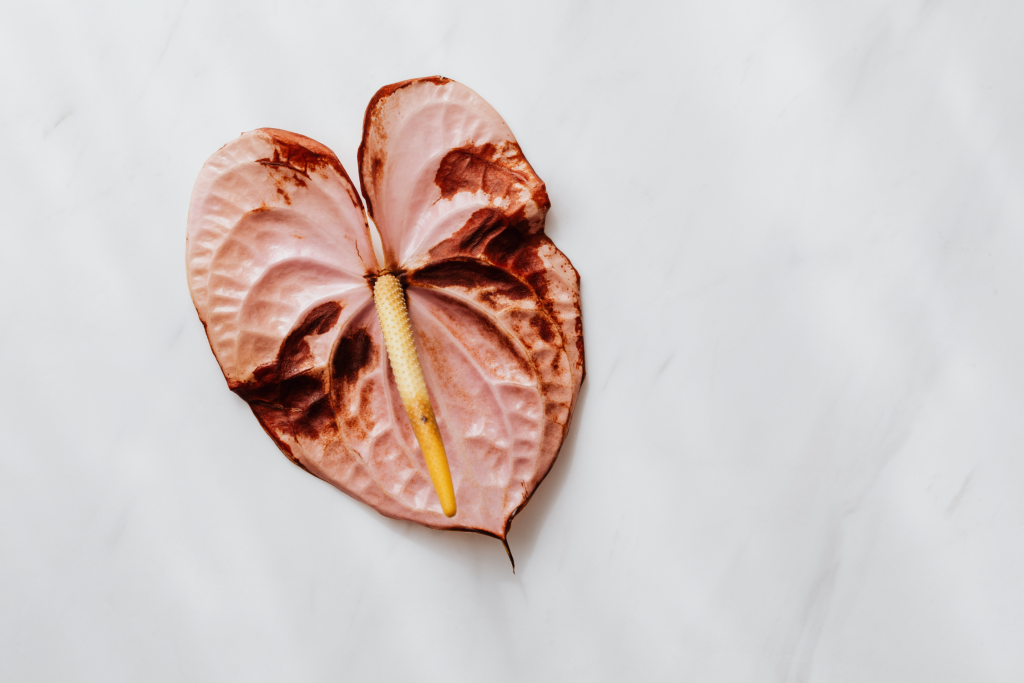
Flamingo Flower Plants (Anthurium) are prized for their vibrant flowers and glossy foliage, but like any plant, they can encounter challenges. Here’s how to identify and address common issues to keep your Flamingo Flower Plant healthy and thriving:
1. Yellowing Leaves
- Cause: Yellowing leaves on a Flamingo Flower Plant can indicate several issues, including overwatering, underwatering, or insufficient light. It can also result from nutrient deficiencies or root rot.
- Solution:
- Watering Adjustments: Ensure you’re watering your plant correctly. Allow the top inch of soil to dry out between waterings to prevent waterlogging, which can lead to root rot.
- Lighting: Ensure your plant is receiving adequate indirect light. Move it to a brighter location if necessary, but avoid direct sunlight, which can scorch the leaves.
- Nutrient Balance: Feed your plant with a balanced fertilizer formulated for flowering houseplants. Follow the recommended feeding schedule to ensure it receives essential nutrients.
2. Brown Leaf Tips
- Cause: Brown leaf tips typically indicate low humidity levels, over-fertilization, or salts in the soil.
- Solution:
- Humidity Increase: Increase humidity around the plant by misting regularly or placing it on a humidity tray filled with water and pebbles.
- Fertilization Adjustment: Reduce the frequency or strength of fertilization to prevent salt buildup in the soil, which can burn the roots and cause leaf tip browning.
3. Flower Dropping
- Cause: Premature flower dropping can occur due to changes in environmental conditions, such as temperature fluctuations, drafts, or stress.
- Solution:
- Stable Environment: Ensure your Flamingo Flower Plant is placed in a stable environment with consistent temperature and humidity levels.
- Avoid Drafts: Protect the plant from drafts and sudden temperature changes, which can stress the plant and cause flowers to drop prematurely.
4. Pests
- Common Pests: Flamingo Flower Plants are susceptible to pests such as aphids, spider mites, and scale insects.
- Solution:
- Monitoring: Regularly inspect your plant for signs of pests, such as yellowing leaves, sticky residue (honeydew), or visible insects.
- Treatment: Treat infestations promptly with insecticidal soap, neem oil, or a gentle pesticide recommended for houseplants. Ensure thorough coverage, including undersides of leaves where pests often hide.
5. Root Rot
- Cause: Root rot is typically caused by overwatering or poorly draining soil, leading to fungal infections that attack the roots.
- Solution:
- Proper Watering: Adjust your watering practices to allow the top inch of soil to dry out before watering again. Ensure pots have drainage holes and use a well-draining potting mix.
- Trim Affected Roots: If root rot is detected, carefully trim affected roots with sterile scissors and repot the plant in fresh, well-draining soil.
6. Disease
- Common Diseases: Flamingo Flower Plants can be susceptible to fungal diseases like leaf spot or bacterial infections under conditions of high humidity and poor air circulation.
- Solution:
- Preventive Care: Maintain good air circulation around the plant by spacing it adequately from other plants. Avoid overcrowding and ensure humidity levels are optimal for the plant’s needs.
- Fungicide Treatment: If fungal diseases are detected, treat with a fungicide formulated for houseplants. Follow label instructions carefully and continue treatment until the issue is resolved.
7. Cultural Issues
- Cause: Cultural issues such as improper light, temperature extremes, or neglecting to repot can lead to overall decline in plant health.
- Solution:
- Evaluate Growing Conditions: Assess the plant’s environment and make adjustments as needed to ensure it receives adequate light, stable temperatures, and proper humidity.
- Routine Maintenance: Regularly repot your Flamingo Flower Plant every 1-2 years to refresh the soil and provide room for root growth. Trim back overgrown or yellowing foliage to encourage new growth.
Conclusion
By identifying and addressing common problems promptly, you can ensure your Flamingo Flower Plant (Anthurium) remains healthy and vibrant. Regular monitoring, proper watering, adequate light, and proactive pest management are key to maintaining this tropical beauty’s beauty and longevity in your home or garden.



